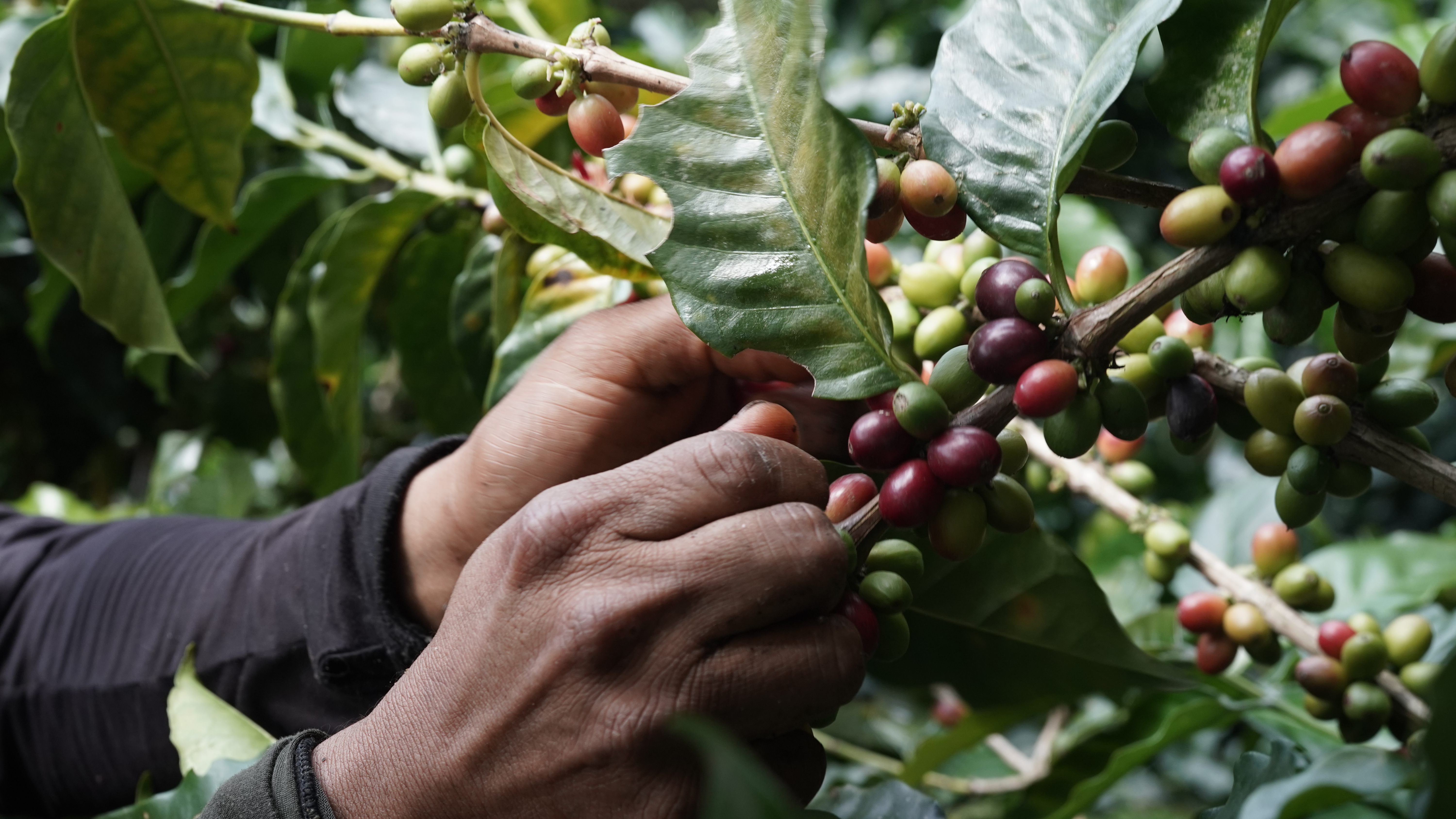A quality cup of coffee is a balance between nature and nurture. One of the most critical factors influencing its flavour, aroma, and quality is temperature. Arabica coffee thrives in temperatures between 18-21°C. So conditions have to be very specific. And there are various environmental factors impacting that, from altitude and ocean currents to rainfall, wind, and climate change.

 Coffee break reading
Coffee break reading
How climate and temperature shapes your favourite cup of coffee

Altitude
Altitude is one of the most significant factors impacting temperature in coffee farming. It’s also one of the greatest tellers of coffee quality and flavour. Higher altitudes mean lots of sun during the day and cooler temperatures at night, which Arabica coffee plants love, typically grown between 1,800 to 6,300 MASL.
The cooler climate slows the growth speed of coffee cherries, allowing them to develop more complex flavours. High-altitude coffee is often prized for its bright acidity, more pronounced fruity notes, and cleaner finish. In contrast, coffee grown at lower altitudes (which have warmer evenings) can be softer, with more mellow and earthy tones.
There are exceptions, though. On particular islands, like Okinawa, Japan, coffee can be grown at much lower altitudes (e.g. 1-200 MASL) and still rank incredibly high in quality thanks to the elements that surround it. Islands like this get much cooler breezes from the surrounding water at night. Giving them that essential extra time to mature.

Distance from water and ocean currents
As explained above, proximity to large bodies of water (e.g. lakes or oceans), can influence temperatures and create a more stable climate. This is crucial for coffee plants, which thrive in environments that don’t have extreme temperature changes.
Warm currents raise temperatures. Cold currents lower them. For example, the Humboldt Current off the coast of Peru brings cooler waters that help create ideal growing conditions for Peruvian coffee. These subtle shifts in temperature, influenced by ocean currents, contribute to the unique characteristics of regional coffees.

Rainfall
Rainfall is another vital factor in coffee cultivation. Adequate rainfall ensures that coffee plants get the necessary hydration, but too much or too little can be detrimental. Rainfall affects temperature by providing cooling through evaporation. Regions with well-distributed rainfall and moderate temperatures, like parts of Central America, often produce high-quality coffee with vibrant flavours.
Topography and aspect
The topography of the land (the arrangement of natural and artificial features in an area), including hills and valleys, affects how sunlight and temperature impact coffee plants. The compass direction a slope faces (aka. aspect) also plays a crucial role. South-facing slopes in the Northern Hemisphere receive more sunlight. Warming the land and promoting growth. North-facing slopes, however, can be cooler, which may be preferable in already warm regions.

Prevailing wind
Prevailing winds can bring in cool air from the oceans or warm air from the land. These winds can reduce the risk of frost in higher-altitude regions. In some areas, windbreaks are planted to protect coffee crops from harsh winds that could otherwise damage the delicate plants.
Latitude
Coffee is grown along the ‘bean belt’ – a region between the Tropics of Cancer and Capricorn. Within this belt, latitude influences temperature. Closer to the equator, temperatures are warmer and more consistent year-round. As you move further out, temperatures can become cooler, especially at higher altitudes. This balance of latitude and altitude creates the perfect conditions for coffee cultivation.

How climate change is impacting your coffee
To grow coffee, farmers need very specific conditions. And climate change makes it much harder for farmers to do that. Consequences of climate change, like rising temperatures, unpredictable rainfall, droughts, and soil damage, can lead to increased pests and diseases and even wipe out entire harvests.
These changes are threatening the livelihoods of coffee farmers. Forcing them to move to higher altitudes and adopt agroforestry methods. In many cases, it’s forcing them to cut down trees to diversify their crops. Their quality of life is impacted, as is the quality of their coffee, its availability for consumers, and its retail price.

What it means for you
It’s never been more important to understand what a difference temperature makes. Understanding these nuances means you can make more educated buying decisions, know why your coffee tastes the way it does, and gain insight into the impacts of global warming.
Whether you prefer the bright and lively notes of a high-altitude Rwandan coffee or the smooth, chocolatey flavours of a lower-altitude Brazil/Colombian blend, climate and temperature play a key role in delivering the taste experiences you love. And it’s crucial – for the planet, the farmer, and you – to acknowledge how delicate coffee conditions are and preserve them for generations to come.
How climate and temperature shapes your favourite cup of coffee
A quality cup of coffee is a balance between nature and nurture. One of the most critical factors influencing its flavour, aroma, and quality is temperature. Arabica coffee thrives in temperatures between 18-21°C. So conditions have to be very specific. And there are various environmental factors impacting that, from altitude and ocean currents to rainfall, wind, and climate change.

Altitude
Altitude is one of the most significant factors impacting temperature in coffee farming. It’s also one of the greatest tellers of coffee quality and flavour. Higher altitudes mean lots of sun during the day and cooler temperatures at night, which Arabica coffee plants love, typically grown between 1,800 to 6,300 MASL.
The cooler climate slows the growth speed of coffee cherries, allowing them to develop more complex flavours. High-altitude coffee is often prized for its bright acidity, more pronounced fruity notes, and cleaner finish. In contrast, coffee grown at lower altitudes (which have warmer evenings) can be softer, with more mellow and earthy tones.
There are exceptions, though. On particular islands, like Okinawa, Japan, coffee can be grown at much lower altitudes (e.g. 1-200 MASL) and still rank incredibly high in quality thanks to the elements that surround it. Islands like this get much cooler breezes from the surrounding water at night. Giving them that essential extra time to mature.

Distance from water and ocean currents
As explained above, proximity to large bodies of water (e.g. lakes or oceans), can influence temperatures and create a more stable climate. This is crucial for coffee plants, which thrive in environments that don’t have extreme temperature changes.
Warm currents raise temperatures. Cold currents lower them. For example, the Humboldt Current off the coast of Peru brings cooler waters that help create ideal growing conditions for Peruvian coffee. These subtle shifts in temperature, influenced by ocean currents, contribute to the unique characteristics of regional coffees.

Rainfall
Rainfall is another vital factor in coffee cultivation. Adequate rainfall ensures that coffee plants get the necessary hydration, but too much or too little can be detrimental. Rainfall affects temperature by providing cooling through evaporation. Regions with well-distributed rainfall and moderate temperatures, like parts of Central America, often produce high-quality coffee with vibrant flavours.
Topography and aspect
The topography of the land (the arrangement of natural and artificial features in an area), including hills and valleys, affects how sunlight and temperature impact coffee plants. The compass direction a slope faces (aka. aspect) also plays a crucial role. South-facing slopes in the Northern Hemisphere receive more sunlight. Warming the land and promoting growth. North-facing slopes, however, can be cooler, which may be preferable in already warm regions.

Prevailing wind
Prevailing winds can bring in cool air from the oceans or warm air from the land. These winds can reduce the risk of frost in higher-altitude regions. In some areas, windbreaks are planted to protect coffee crops from harsh winds that could otherwise damage the delicate plants.
Latitude
Coffee is grown along the ‘bean belt’ – a region between the Tropics of Cancer and Capricorn. Within this belt, latitude influences temperature. Closer to the equator, temperatures are warmer and more consistent year-round. As you move further out, temperatures can become cooler, especially at higher altitudes. This balance of latitude and altitude creates the perfect conditions for coffee cultivation.

How climate change is impacting your coffee
To grow coffee, farmers need very specific conditions. And climate change makes it much harder for farmers to do that. Consequences of climate change, like rising temperatures, unpredictable rainfall, droughts, and soil damage, can lead to increased pests and diseases and even wipe out entire harvests.
These changes are threatening the livelihoods of coffee farmers. Forcing them to move to higher altitudes and adopt agroforestry methods. In many cases, it’s forcing them to cut down trees to diversify their crops. Their quality of life is impacted, as is the quality of their coffee, its availability for consumers, and its retail price.

What it means for you
It’s never been more important to understand what a difference temperature makes. Understanding these nuances means you can make more educated buying decisions, know why your coffee tastes the way it does, and gain insight into the impacts of global warming.
Whether you prefer the bright and lively notes of a high-altitude Rwandan coffee or the smooth, chocolatey flavours of a lower-altitude Brazil/Colombian blend, climate and temperature play a key role in delivering the taste experiences you love. And it’s crucial – for the planet, the farmer, and you – to acknowledge how delicate coffee conditions are and preserve them for generations to come.





